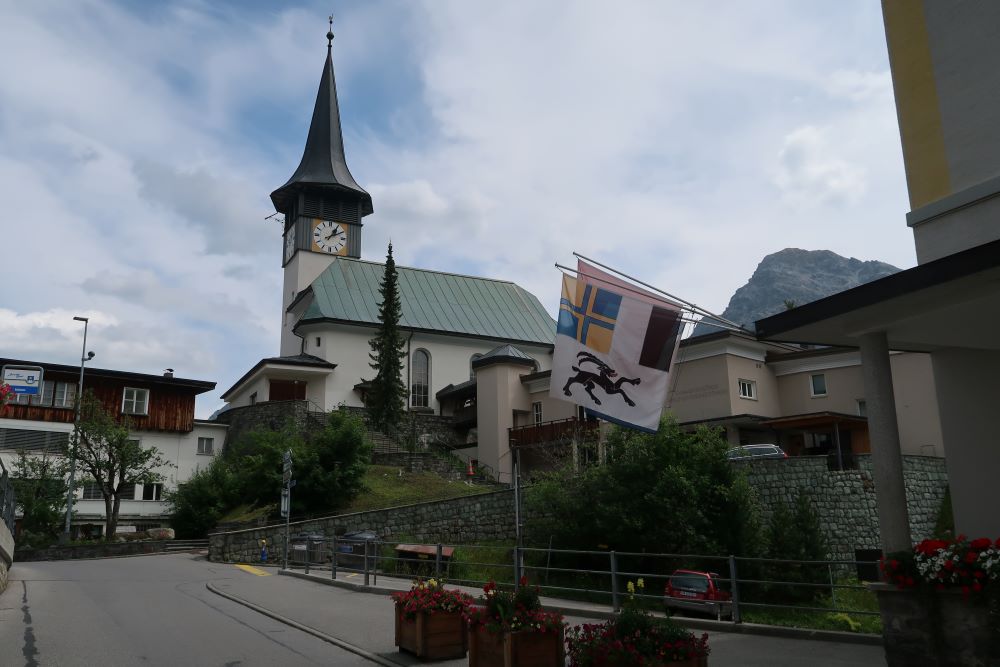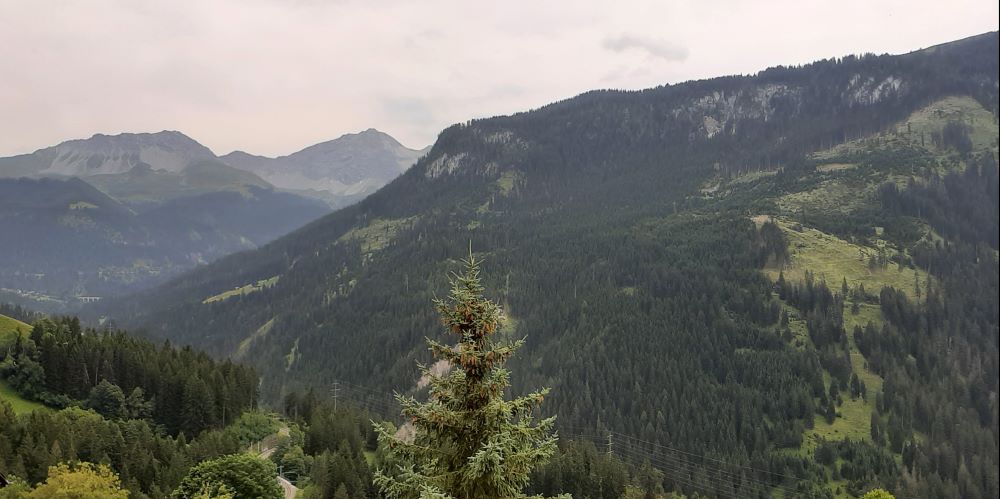Arosa, Lenzerheide and Tschiertschen
4 August 2023
The ancient episcopal town of Chur is close to Reichenau, where the Hinterrhein and Vorderrhein continue as the Alpine Rhine in the Rhine Valley up to Lake Constance (Bodensee). Chur is also the traffic hub for the direction of Arosa, Lenzerheide, Disentis/Mustér and the most beautiful village in Switzerland and Liechtenstein: Tschiertschen.

Chur seen from the road to Arosa
Arosa and the Schanfigg Valley
The first written indication of Schanfigg is Scanavico in the year 765. The villages of Lüen (1084), Castiel (1132), St Peter (831), Pagig (1160) and Calfeisen (1156) are also ancient villages, where Romanesque was the language of communication until the 16th century.
From Davos, a Walser village, Walser immigrated over the Strelapas to the Schanfigg Valley in the 13th and 14th centuries. They founded Arosa and Langwies.
With the extinction of local noble rulers (in 1338, the Freiherren von Vaz and 1436, the Counts of Toggenburg), autonomous Gerichtsgemeinden also developed in this barren area.






Villages in the Schanfigg Valley
Arosa and the other villages were part of the Gerichtsgemeinde Davos, the capital of the Zehngerichtenbund (1436). Langwies was also a Gerichtsgemeinde. St Peter was part of the Gerichtsgemeinde (Ausser)Schanfigg but was the location of the Landsgemeinde of the Schanfigg valley.
The Zehngerichtenbund concluded a treaty with the Gotteshausbund (1367) in 1450 and with the Graue or Obere Bund (1395) in 1470. However, the Gerichtsgemeinden remained autonomous (apart from their formal status as part of the Holy Roman Empire until 1648 and the Peace of Westphalia) until their dissolution in 1798.
Apart from the Reformation from 1530 onwards and the devastation in 1622 at the time of the Bünder Wirren (1619-1639), little changed politically, socially and economically in most residents’ predominantly poor agricultural existence.
The French occupation changed the political situation in 1798. The Freistaat der Drei Bünde was dissolved. and the Helvetic Republic (1798-1803), the Confederation (Act of Mediation) and the establishment of canton Graubünden (1803-1813), the new Confederation in 1815 and finally the New Constitution of 1848 were the new political realities.
Arosa (with only 56 inhabitants by then) became an independent municipality in 1851. However, tourism changed Arosa in the following decades. The village developed into a well-known winter sports and tourist resort. As a result of these developments, Arosa had over 3 300 inhabitants in 1930, fifty times more than half a century before!





Arosa today
The first hotel opened in 1877, followed by the first sanatorium in 1888. The Chur-Arosa road was completed in 1890, but the canton had banned motorised vehicles until 1925. Since 1914 trains have been running between Chur and Arosa with a 264-long and 62-high viaduct at Langwies. The Rhaetian Railway operates this railway with a rise from 593 to 1738 metres in less than an hour!


Langwies viaduct
The trip from Chur to Arosa through the Chanfigg Valley, by car, train, bicycle, motorbike or on foot, is worthwhile in all seasons. While the other villages have benefited far less from tourism, it is a blessing for the preservation of the equally ancient buildings. Today, the villages in the valley are incorporated into the municipality of Arosa.




The Schanfigg Valley


Chur seen from the road to Lenzerheide
Lenzerheide, Malix and Churwalden
Lenzerheide has a similar history to Arosa. It was also a tiny Walser village on the way to Tiefencastel. From the mid-nineteenth century, tourism also changed the life and appearance of the village here.



Lenzerheide


Heidisee near Lenzerheide


However, the route to Lenzerheide is more interesting in cultural-historical terms. The Walser people also settled here in the 13th and 14th centuries. The old monastery (9th century) and Abthaus (15th century) in Churwalden, the ruins of the castle (around 1150) of the Freiherren von Vaz in Malix or beyond Lenzerheide the Val Obervaz are some highlights.

Remains of the castle near Malix

Churwalden monastery

The Monastery and Abtshaus Churwalden. Johann Rudolf Rahn (1841-1912), Churwalden abbey, on the right, the still existing abbot’s house on the left. Drawing around 1900. Zentralbibliothek Zürich, Graphische Sammlung and Fotoarchiv
Tschiertschen, Pagguss and Praden
The road to Lenzerheide, however, holds another secret. The turnoff to the village of Tschiertschen is the road to ‘the most beautiful village in Switzerland‘. Moreover, on the Pagguss Gorge, the village of Pagguss is home to the EHL Hotelfachschule.
Tschiertschen is known, among other things, for its Romanesque-Gothic church from the 14th century.

EHL Hotelfachschule.



The Pagguss-Schlucht
The village of Praden shared the church and cemetery with Tschiertschen for a long time. Still, politically Praden belonged to the Gerichtsgemeinde Langwies and Tschiertschen to the Gerichtsgemeinde Churwalden, both members of the Zehngerichtenbund.
However, the history of Praden and Tschiertschen continues. The Reformation took place in 1540, obviously after a vote among citizens; moreover, the parish priest was allowed to stay on until his death, and only then (1550) was a preacher appointed!



Tschiertschen
The two villages fell under different courts in Langwies and Churwalden but shared the church and cemetery in Tschiertschen. A plague epidemic 1627 caused some of Chur’s elite to flee to isolated Tschiertschen in 1629. However, the victims of the plague in Praden were also buried in Tschiertschen. The refugees from Chur wanted to prevent it because of contamination risks.


Praden
Praden built its church and cemetery with money from Chur residents around 1630. Tschiertschen did not accept it for financial reasons. After all, Praden no longer shared in the costs of the church in Tschiertschen. A legal battle ensued with courts Langwies and Churwalden, a court of appeal in Davos and an arbitration commission in Chur.
The legal proceedings lasted until 1762. Then, in a final judgment, the court decided that every household in Praden should deliver to the parish in Tschiertschen an annual Füederli (a piece of firewood). In any case, the fact is that both churches are still there, one even in the ‘most beautiful village in Switzerland’.
(Source and further information:Arosa and Lenzerheide; M. Domann, G. Jäger, Die Kirche von Tschiertschen, Tschiertschen, 2014)





